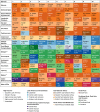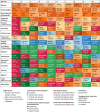The global burden of disease study 2013: What does it mean for the NTDs?
- PMID: 28771480
- PMCID: PMC5542388
- DOI: 10.1371/journal.pntd.0005424
The global burden of disease study 2013: What does it mean for the NTDs?
Conflict of interest statement
PJH is principal investigator and patentholder on various vaccines in development that would provide protection from neglected tropical diseases. DSS has received grant funding from Sanofi Pasteur. The other authors declare no conflicts of interest.
Figures







References
-
- Hotez PJ, Alvarado M, Basáñez MG, Bolliger I, Bourne R, Boussinesq M, et al. The global burden of disease study 2010: interpretation and implications for the neglected tropical diseases. PLoS Negl Trop Dis. 2014;8(7):e2865 doi: 10.1371/journal.pntd.0002865 ; PubMed Central PMCID: PMC4109880. - DOI - PMC - PubMed
-
- Global Burden of Disease DALYS HALE Collaborators, Murray CJ, Barber RM, Foreman KJ, Abbasoglu Ozgoren A, Abd-Allah F, et al. Global, regional, and national disability-adjusted life years (DALYs) for 306 diseases and injuries and healthy life expectancy (HALE) for 188 countries, 1990–2013: quantifying the epidemiological transition. Lancet. 2015;386(10009):2145–91. doi: 10.1016/S0140-6736(15)61340-X ; PubMed Central PMCID: PMC4673910. - DOI - PMC - PubMed
-
- Global Burden of Disease Study Collaborators. Global, regional, and national incidence, prevalence, and years lived with disability for 301 acute and chronic diseases and injuries in 188 countries, 1990–2013: a systematic analysis for the Global Burden of Disease Study 2013. Lancet. 2015;386(9995):743–800. doi: 10.1016/S0140-6736(15)60692-4 ; PubMed Central PMCID: PMC4561509. - DOI - PMC - PubMed
-
- Global Burden of Disease Mortality Causes of Death Collaborators. Global, regional, and national age-sex specific all-cause and cause-specific mortality for 240 causes of death, 1990–2013: a systematic analysis for the Global Burden of Disease Study 2013. Lancet. 2015;385(9963):117–71. doi: 10.1016/S0140-6736(14)61682-2 ; PubMed Central PMCID: PMC4340604. - DOI - PMC - PubMed
-
- Beyrer C, Villar JC, Suwanvanichkij V, Singh S, Baral SD, Mills EJ. Neglected diseases, civil conflicts, and the right to health. Lancet. 2007;370(9587):619–27. doi: 10.1016/S0140-6736(07)61301-4 . - DOI - PubMed
Publication types
MeSH terms
Grants and funding
LinkOut - more resources
Full Text Sources
Other Literature Sources
Medical

